Installing plugins one by one can be tedious, especially if you’re working on multiple WordPress sites. We’ve found that bulk-installing plugins is a much faster and more efficient solution.
For anyone building WordPress sites regularly, there’s always a list of must-have plugins that you use every time. Using a bulk installation method, you can quickly set up all your favorite plugins in just a few steps.
In this guide, we’ll show you how to easily bulk-install plugins in WordPress. This step-by-step process is designed to help you work smarter and more efficiently.

Why Bulk Install WordPress Plugins?
With over 59,000 plugins available in the free WordPress.org directory, finding the right tools for your site can be difficult. Most users eventually create a set of must-have plugins they install on every new website.
Having a favorite set of plugins is quite useful for those managing multiple WordPress websites.
For example, we use the plugins from our Ultimate WordPress Toolkit on all our sites because they help us save time and improve productivity.
By default, WordPress allows you to install one plugin at a time through the admin dashboard. While this works, it can become tedious and time-consuming, especially if you have a long list of plugins to install.
Wouldn’t it be great if you could quickly install all your favorite plugins at once?
Bulk installation not only saves time but also spares you the repetitive task of installing and activating each plugin individually.
In this guide, we’ll show you two easy ways to bulk install your favorite plugins on any WordPress site. Whether you’re setting up one site or managing several, this method will make your workflow much smoother.
- Method 1: Bulk Install WordPress Plugins with a Plugin (recommended)
- Method 2: Bulk Install WordPress Plugins with FTP (advanced)
Method 1: Bulk Install WordPress Plugins with a Plugin
The easiest way to upload and install WordPress plugins in bulk is by using the WPCore Plugin Manager plugin. This free tool lets you create a collection of your favorite plugins and quickly install them on a new site.
We recommend WPCore Plugin Manager for:
- Beginners unfamiliar with advanced methods
- Users installing mostly free plugins
- Users who regularly setup new WordPress websites
ℹ️Note: The free version of the WPCore Plugin Manager lets you add only free plugins from WordPress.org. If you want to install custom and premium WordPress plugins from other third-party sites in bulk, we recommend using the FTP method below.
The first thing you need to do is install and activate the WPCore Plugin Manager plugin. For more details, see our step-by-step guide on how to install a WordPress plugin.
Creating a Bulk WordPress Plugin Collection
Before you bulk install WordPress plugins on your new site, you’ll first need to create a collection of plugins. Basically, you’ll take a ‘snapshot’ of all the plugins already installed so you can recreate the same setup on any website.
Upon activation, the plugin will add a new menu labeled WPCore in your WordPress admin panel. You need to click on it to configure settings.
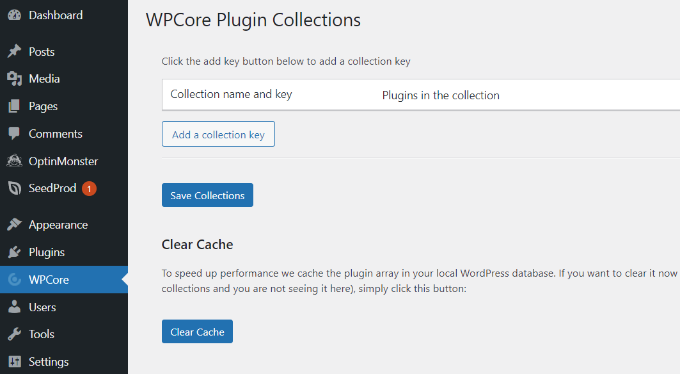
On the WPCore plugin collections page, you will be prompted to add a collection name and key to import plugins.
To do this, you’ll need to create a plugin collection with your selected plugins and get the key on the WPCore website.
To begin, click on the ‘Create your FREE account’ button.
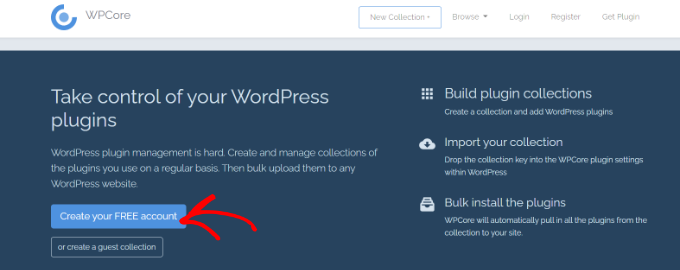
Next, you will see the registration page. Go ahead and create your account.
Once you’re registered, WPCore will allow you to create your new plugin collection.
You can then simply add a collection title and description, as well as choose whether the collection will Public or Private. Then click on the ‘Continue’ button.
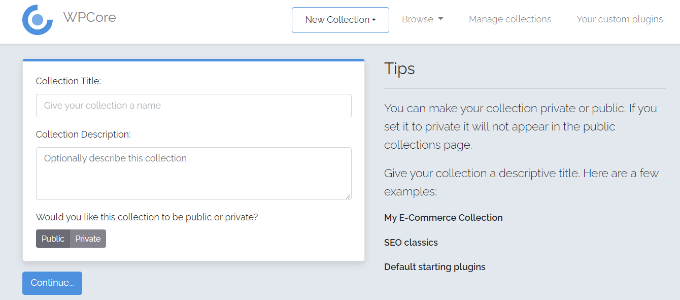
After that, it will create a collection where you can add your favorite plugins in it.
Simply click on the plus icon next to ‘WordPress.org plugins’ to add plugins from the official WordPress plugin repository.
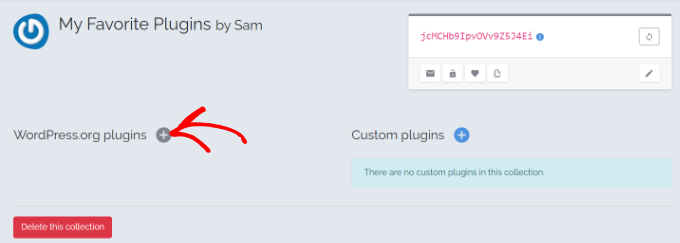
After that, a new popup window will appear where you can search for a WordPress plugin by its name. For example, we will search ‘WPForms.’
Now, WPCore will search the plugin repository and show all the results related to the search term. Once the results appear, you need to choose the right option and click on it.

Doing so will add the plugin to the collection.
Simply repeat the same step to add more plugins.
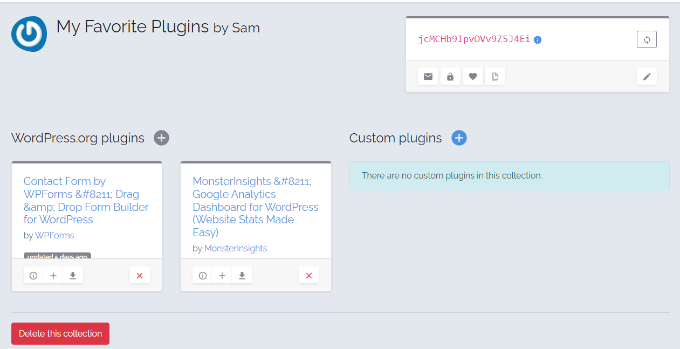
Once you have added all of your must-have WordPress plugins, navigate to a small box at the top right side of your screen.
The code in the red text inside the box is your plugin collection key. Go ahead and copy the code. You will need it in the next steps.
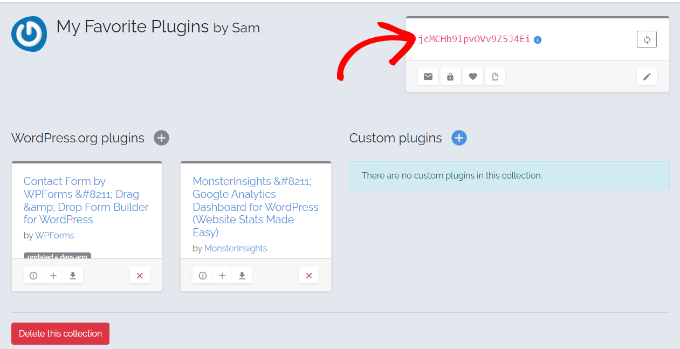
Installing Bulk WordPress Plugins with WPCore
Next, you have to add that collection key to the WordPress site where you installed the WPCore plugin earlier.
Go ahead and open the WPCore plugin from your admin panel and click on the ‘Add a collection key’ button.
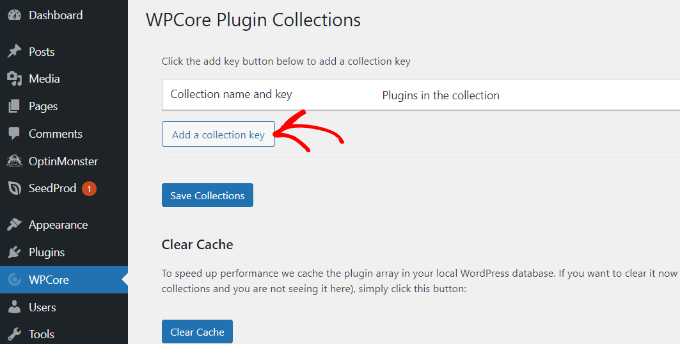
After that, you will see a field titled ‘Collection name and key.’
Simply paste the key that you copied earlier and click on the ‘Save Collections’ button.
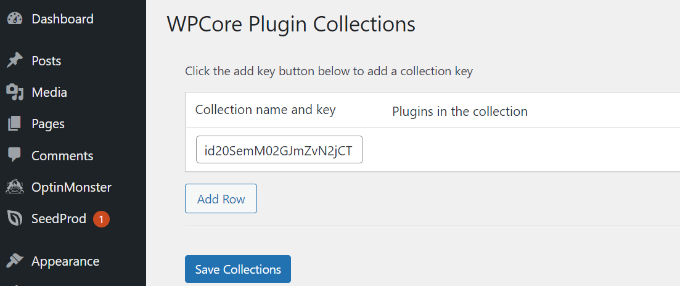
WPCore will now load your plugin collection and prepare for installation. It will add a notification at the top of the screen that reads ‘WPCore recommends the following plugins.”
You just need to click on the ‘Begin installing plugins’ option, and WPCore will start installing the plugins in your collection.
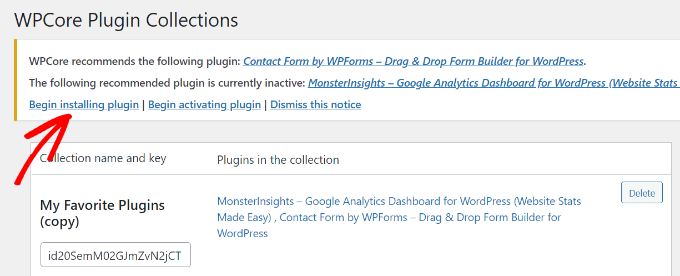
On the next screen, you will be taken to the Plugins » Install Plugins page that shows a list of your collection.
To install the plugins in bulk, select all by clicking on the checkbox next to the ‘Plugin’ option at the top.
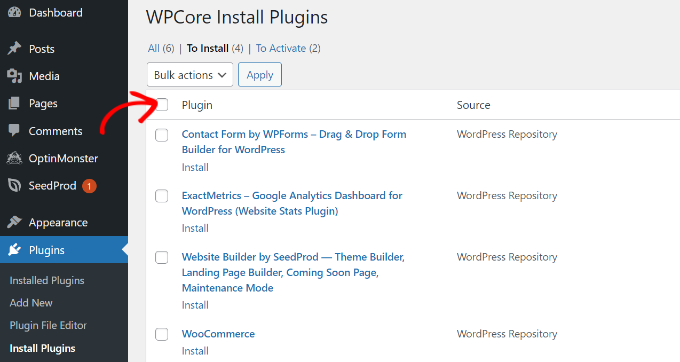
Once all the plugins are selected, click on the dropdown menu and choose the ‘Install’ option.
Next, you can click on the ‘Apply’ button.
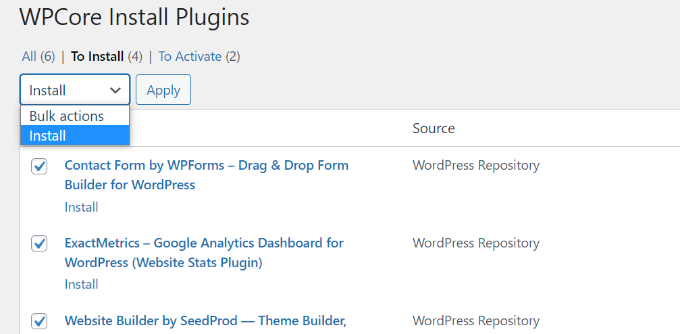
After that, WordPress will install the plugins one by one.
Once done, it will notify you with an ‘All installations have been completed’ message.
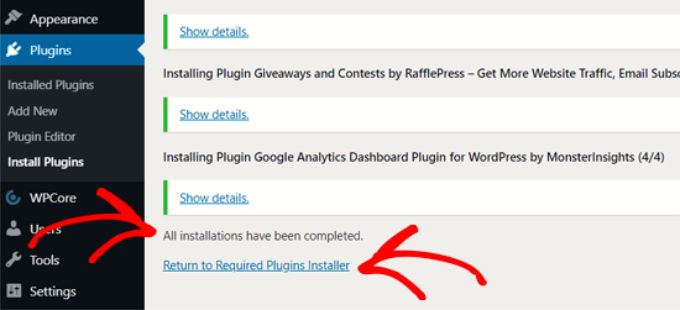
Then, simply click on the ‘Return to Required Plugins Installer.’
On the next screen, you will see the list of plugins that you just installed. Now, you just have to activate these plugins by clicking on the checkbox next to ‘Plugins’ once again and choosing the ‘Activate’ option from the dropdown.
After that, click on the ‘Apply’ button.
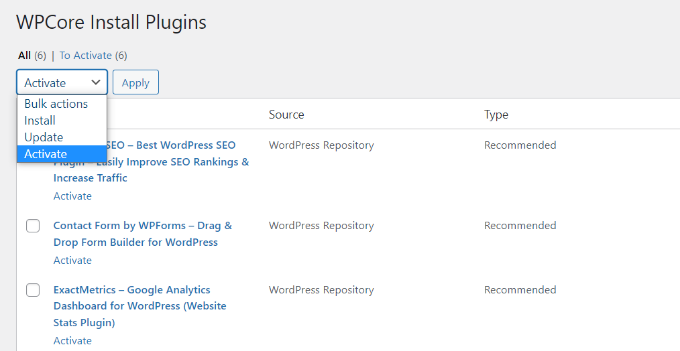
Now WordPress will activate all the plugins one by one.
Once done, it will display a notification message to inform you that all plugins are active.
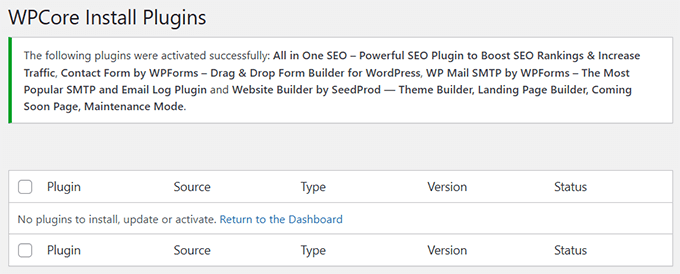
After that, you can see your installed plugins by going to the Plugins » Installed Plugins page from your dashboard.
They should all show as active plugins in the list.

Now you can start configuring your plugin settings and other configurations on your website.
Method 2: Bulk Install WordPress Plugins with FTP
Using a File Transfer Protocol (FTP) client is another effective way to bulk install WordPress plugins. It allows you to upload files directly from your computer to your website’s server, which is particularly useful for premium plugins or custom setups.
In our experience, FTP is a great option when you want to install multiple plugins that aren’t available in the WordPress.org directory. For instance, we often use FTP to upload premium plugins like those in our Ultimate WordPress Toolkit, which includes our go-to plugins for all new sites.
First, you’ll need FTP credentials to connect to your WordPress site. These are typically found in the email from your hosting provider or in the cPanel dashboard of your hosting account.
For example, if you’re using Bluehost, navigate to your account dashboard and click on the Site Settings button.
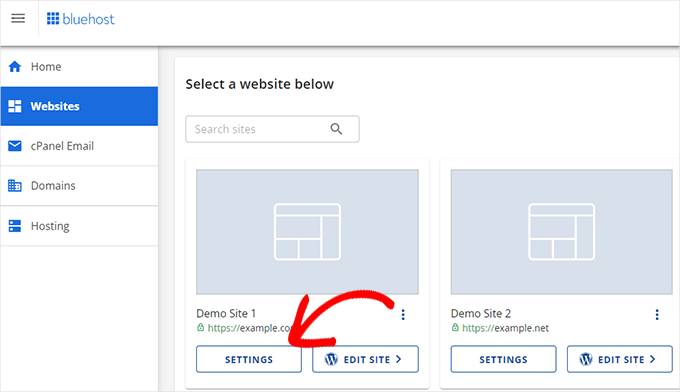
Switch to the Advanced tab and scroll to the cPanel section.
Next, you need to click Manage to launch the cPanel dashboard.
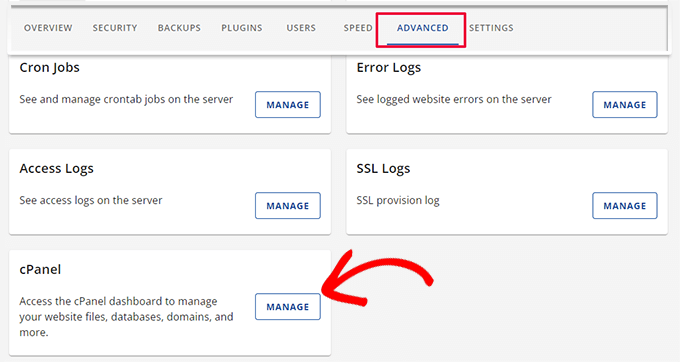
In the cPanel, locate the Files section and click on FTP Accounts to find your login credentials.
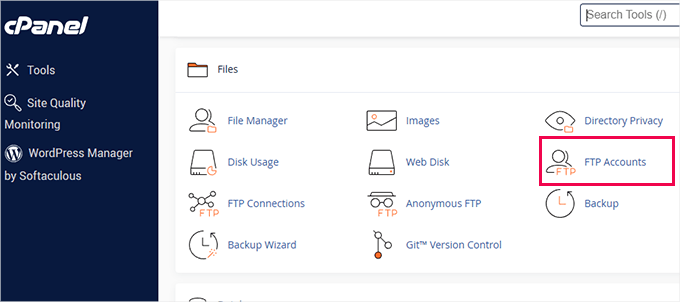
Next, choose an FTP client. We recommend FileZilla, one of the best FTP clients for beginners and advanced users alike.
Once FileZilla is installed, open it and navigate to File » Site Manager. Add a new site and enter the FTP credentials you found earlier. Ensure the Host field includes ‘ftp.’ before your domain name, such as ftp.example.com.

After connecting, you’ll see your local files on the left and your website files on the right.
Make sure the plugin files are extracted from their zip folders before uploading.

On the right side, navigate to the /wp-content/plugins folder.
Drag and drop the extracted plugin folders from your local files to this directory.

For example, we uploaded MemberPress, Sugar Calendar, and WooFunnels plugin folders. These plugins are now ready to use on our site.

Finally, return to your WordPress dashboard, go to Plugins » Installed Plugins page.
Here you will see the plugins you uploaded installed. You can now go ahead and activate them.
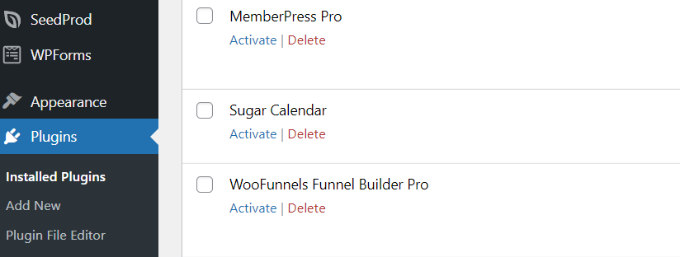
For additional details, check out our guide on using FTP to upload files to WordPress.
Bonus Tip: Hire A WordPress Maintenance Service
WordPress requires regular maintenance tasks like keeping software updated, installing plugins, keeping backups, and more.
All of which takes time. For small businesses this time can be used on other areas of growth.
If managing plugins is taking too much of your time, then consider WPBeginner’s WordPress Maintenance Service.
For a small fee, our team of WordPress experts will keep all your WordPress plugins, themes, and core software updated. Plus, you will get cloud backup and 24/7 uptime monitoring.
We hope this article helped you learn how to bulk install plugins in WordPress. You may also want to see our guide on how to speed up WordPress and improve your WordPress security.
If you liked this article, then please subscribe to our YouTube Channel for WordPress video tutorials. You can also find us on Twitter and Facebook.





kzain
Bulk installing plugins seems like a time-saver, especially when setting up a new website! The WPCore Plugin Manager plugin sounds like a convenient option
Jiří Vaněk
Thank you for the article. I currently use FTP to automate the installation of plugins, through which I also install WordPress. I have a folder with plugins on my PC as a default list of what should not be missing on the website and I just copy it to wp-content/plugins. The downside is that of course I have to mass activate and update afterwards. But it’s just a few clicks away. Thanks for the plugin recommendation. I assume that once the bulk install of the plugins is done, I can then remove the plugin as I won’t be using it on the site anymore?
WPBeginner Support
Correct you would be able to remove the plugin afterward if you wanted to
Admin
Jiří Vaněk
Thank you, that’s exactly what I needed to know, so I don’t have to maintain another plugin unnecessarily. I’ve been doing something similar manually via FTP, but it’s just extra work. This method of bulk installation seems much more convenient, especially since I don’t always have access to FTP. Thank you for your time and the truly valuable advice that has already saved me dozens of hours of hard work. Automation is simply awesome.
Akanja
Nice article
WPBeginner Support
Thank you
Admin
Juan Furlan
What a shame. The plugin seems to be abandoned.
Editorial Staff
We updated the article with a new solution
Admin
Juan Furlan
Thanks for this article.
I was looking for this solution for a long time.
Julian M.
I prefer to use the command line and wp tool. For instance:
> wp plugin install akismet –activate
This will install and activate the add-in. Very handy to install plugins in bulk via SSH. You can prepare the list of plugins in a text file and then process all at once.
Kurt
Unless you are just wanting to let us know that you know of a different way, would you mind giving more details? What is wp tool, and is the command run in root? It would be great to be able to install plugins on all domains on a sever at once.
thanks
Yao Daniel
Hi bro!
Many thanks for this great idea.
Is it possible to bulk install premium plugins as well?
If yes, how can I get it.
Thanks again and stay blessed.
Editorial Staff
Yes with the new plugin that we mentioned above, it lets you install premium and custom plugins
Admin
Hardeep Asrani
That’s be a great idea for client websites.
Hardeep Asrani
There should be an option to edit comments within 5 minutes, lol.
** That would be
Barbara
I’ve been using Plugin Central to do this for a few years. It doesn’t have the option to save a profile like this plugin does, but I just keep a list of my favorites in a text document and copy the list whenever I do an install. It does, however, have the option to activate all the plugins after installation.
* And, yes, Floating Social Bar is on my list of favorite plugins to install!
Naser
Thank you so much for the alternative Barbara. The Bulk Install Profiles plugin was giving me a hard time now and then. Plugin Central works like a charm.
Zimbrul
That’s brilliant! I can say I’ve got core plugins I install on every site such as Yoast’s WordPress SEO or SEO Images, database management plugins, sitemap plugin, etc.
I think this WP Install Profiles plugin comes handy.
Nuno
Hello!
Great post and very helpful.
Could one desable the plugin after install the plugins?
Thanks!
Regards,
Nuno
WPBeginner Support
Nuno, this plugin will only help you install the plugins, it will not auto activate them. You will have to go to Plugins screen and check all plugins and then use Activate from Bulk Actions and apply. To disable plugins you can deactivate them one by one, or bulk deactivate them.
Admin